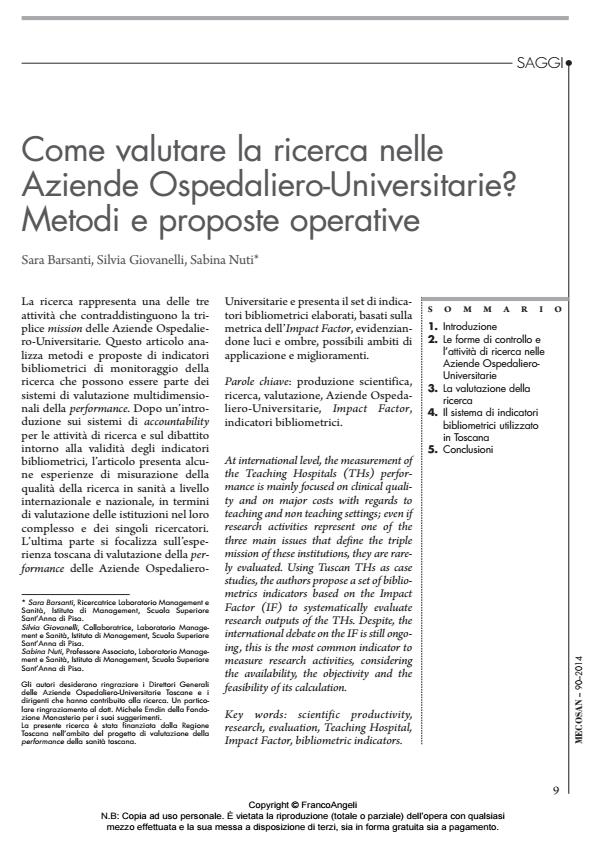Come valutare la ricerca nelle Aziende Ospedaliero-Universitarie? Metodi e proposte operative
Journal title MECOSAN
Author/s Sara Barsanti, Silvia Giovanelli, Sabina Nuti
Publishing Year 2014 Issue 2014/90
Language Italian Pages 24 P. 9-32 File size 424 KB
DOI 10.3280/MESA2014-090002
DOI is like a bar code for intellectual property: to have more infomation
click here
Below, you can see the article first page
If you want to buy this article in PDF format, you can do it, following the instructions to buy download credits

FrancoAngeli is member of Publishers International Linking Association, Inc (PILA), a not-for-profit association which run the CrossRef service enabling links to and from online scholarly content.
At international level, the measurement of the Teaching Hospitals (THs) performance is mainly focused on clinical quality and on major costs with regards to teaching and non teaching settings; even if research activities represent one of the three main issues that define the triple mission of these institutions, they are rarely evaluated. Using Tuscan THs as case studies, the authors propose a set of bibliometrics indicators based on the Impact Factor (IF) to systematically evaluate research outputs of the THs. Despite, the international debate on the IF is still ongoing, this is the most common indicator to measure research activities, considering the availability, the objectivity and the feasibility of its calculation.
Keywords: Scientific productivity, research, evaluation, Teaching Hospital, Impact Factor, bibliometric indicators
- Do university hospitals perform better than general hospitals? A comparative analysis among Italian regions Sabina Nuti, Tommaso Grillo Ruggieri, Silvia Podetti, in BMJ Open /2016 pp.e011426
DOI: 10.1136/bmjopen-2016-011426 - The Italian interregional performance evaluation system Federico Vola, Vera Benedetto, Milena Vainieri, Sabina Nuti, in Research in Health Services & Regions 10/2022
DOI: 10.1007/s43999-022-00010-6 - Diversità di genere e performance organizzativa: un'analisi empirica nel settore sanitario Valeria Naciti, Guido Noto, Carlo Vermiglio, in MECOSAN 120/2022 pp.45
DOI: 10.3280/MESA2021-120004
Sara Barsanti, Silvia Giovanelli, Sabina Nuti, Come valutare la ricerca nelle Aziende Ospedaliero-Universitarie? Metodi e proposte operative in "MECOSAN" 90/2014, pp 9-32, DOI: 10.3280/MESA2014-090002